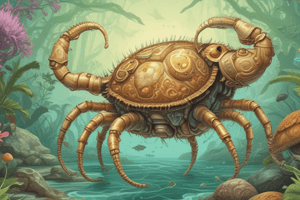Podcast
Questions and Answers
How do arthropods distinguish themselves from other invertebrate groups?
How do arthropods distinguish themselves from other invertebrate groups?
Arthropods have hard exoskeletons made of chitin and jointed appendages, features not found in other invertebrates.
What are the three body regions of arthropods?
What are the three body regions of arthropods?
The three body regions of arthropods are the head, thorax, and abdomen.
Describe the type of circulatory system found in arthropods.
Describe the type of circulatory system found in arthropods.
Arthropods possess an open circulatory system, which includes a dorsal heart and arteries.
What role does chitin play in the anatomy of arthropods?
What role does chitin play in the anatomy of arthropods?
How do arthropods respire in aquatic environments?
How do arthropods respire in aquatic environments?
What is the significance of the haemocoel in arthropods?
What is the significance of the haemocoel in arthropods?
What type of muscle tissue primarily makes up the muscles of arthropods, and why is it important?
What type of muscle tissue primarily makes up the muscles of arthropods, and why is it important?
Explain the concept of sexual dimorphism in arthropods.
Explain the concept of sexual dimorphism in arthropods.
Why is the well-developed brain significant in arthropods?
Why is the well-developed brain significant in arthropods?
What is the function of compound eyes in arthropods?
What is the function of compound eyes in arthropods?
Flashcards are hidden until you start studying
Study Notes
Phyla Overview
- Major phyla include Mollusca, Arthropoda, and Echinodermata.
- Protochordates represent a key group of invertebrates.
Learning Outcomes
- Ability to distinguish arthropods from other invertebrates.
- Understanding the structure and function of arthropods.
- Comparison of different arthropod members.
- Recognition of the importance of arthropods to humans and the environment.
References for Invertebrate Study
- "A Life of Invertebrates" – W.D. Russell-Hunter
- "A Text Book of Zoology" – T.J. Parker and W.A. Haswell
- "Invertebrates" – R.D. Barnes
- "Invertebrate Zoology" – E.E. Ruppert, R.S. Fox, R.D. Barnes
- General biology textbooks.
Examples of Arthropods
- Insects: ants, flies, mosquitoes, cockroaches, beetles.
- Arachnids: spiders, scorpions.
- Myriapods: centipedes, millipedes.
- Crustaceans: crabs, crayfish, shrimp, lobsters, barnacles.
Characteristics of Arthropoda
- Comprises 80% of known animal species.
- Possesses hard exoskeletons and jointed appendages.
- Exhibits bilateral symmetry and is triploblastic.
- Found in diverse habitats: land, freshwater, and marine environments.
- Body segmented into three regions: Head, Thorax, Abdomen.
Physiology of Arthropods
- Hemocoel serves as the main body cavity filled with hemolymph (blood).
- Blood is white and circulates in an open system, featuring a dorsal heart.
- Well-developed central nervous system with a highly developed head containing sensory organs and brain.
- Digestive tract is complete, featuring a mouth and anus at opposite ends.
Vision and Respiration
- Compound eyes allow for mosaic vision; used primarily for navigation and detecting movement.
- Respiration strategies vary: body surface in terrestrial arthropods, gills in aquatic forms, and trachea/book lungs for terrestrial respiration.
Reproductive and Muscular Features
- Separate sexes with sexual dimorphism present.
- Musculature primarily striated, enabling fast contractions, crucial for flight in many insect species.
Coelom Status
- True coelomic nature is present, but in arthropods, the coelom is functionally replaced by the hemocoel.
Studying That Suits You
Use AI to generate personalized quizzes and flashcards to suit your learning preferences.




